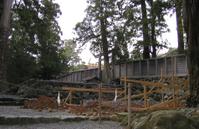I have been assisting a company that is trying to import Japanese soaking tubs into the States. The head person from Japan offered to put me up at a ryokan in Toba, Mie-ken that uses these tubs, so I can experience them (along with experience Japanese hospitality).
We arranged to meet up Friday, so I headed down after class. Arrived at the area after dark, so I didn't have a feel for what it is like. He said that we were right on the ocean.
My expectation of a ryokan is probably something like a Japanese style bed and breakfast. Probably smaller buildings (so only a handful of rooms at most) and Japanese style architecture. When we arrived, I was surprised to see a modern entrance, large lounge, restaurants and karaoke rooms on site, etc., more like I expected for a hotel instead of a ryokan. Place also has 9 stories (though it is on a hill, so only 5 stories stick above the ground), which made it feel more like a hotel.

But once we got into the room, it was all Japanese style, including tatami floors, shoji screens, and sleeping on futons (Japanese style ones, not those couch-things we call futons in the States). We were on the top floor, which had the rooms with the individual tubs. Suite would be more appropriate term than room, as it was 2 rooms with tatami floors, a toilet room, a makeup/changing room, a hall, and the soaking tub on a partially enclosed deck outside. Even sitting on the floor was reasonably comfortable, as they had thick pillows and nice arm rests.

Dinner was a bit later, so we had time to soak. I used the tub that was part of the suite (one of the ones which is the same as what they are trying to import into the States), and he went down to the public onsen. The tub in the suite was made for one person, so we would have had to take turns if we both used it. The tub was comfy and a nice size.
From this point until when we left the next day, we wore yukata (cotton robes). We had dinner in the room. I guess this is standard for this type and level of ryokan. Multiple courses, including sashimi (tai, ebi, tuna, ikura, etc.), various small plates of food, etc. And this wasn't some American-style room service where they roll in a cart of so-so food. Our meal even included having live abalone cooked on a hibachi grill right in front of us, and both a soup and rice being cooked on little burners on the table. The service was spectacular. Even when the woman who was serving us entered our room, she would kneel on the other side of the shoji door to open it, then get up and enter the room.
The business manager was going to go home after dinner, but then he wouldn't be able to drink (drinking and driving is a very big deal in Japan). So I offered for him to stay the night, which he accepted. Figured I had 2 rooms, so we could have our own rooms. Was surprised when they hotel people laid out the futons in the same room, but figured it wasn't a big deal. But I never figured out why there was a second room, as we never used it.

I woke up early (about 6), so went to the onsen downstairs (the tub in our room is not actually onsen water, and I wanted to try the onsen). Then had more spectacular service during our breakfast. Japanese style foods, so miso soup (with about a third of a crab in it), rice, fish, etc. Not something Americans would probably like, but very tasty and filling. The picture of food is actually breakfast - dinner was much more extravagant (and breakfast was already about 12 levels about what I am used to).
We hung out in the room for a while and enjoyed the view of the bay (we had an excellent view from the room). Pretty area, except for the open pit mine on an island across the bay. Many of the rafts in the pictures are part of a oyster farm, similar to what we have in Tomales Bay in California. Local oysters were part of our dinner.
So, I guess a ryokan is not so much the building, but instead the type of room and the excellent service.
日本語:
浴槽をアメリカへ輸入する会社を手伝っている。 社長は鳥羽の旅館に泊まってくださる。その旅館は会社の浴槽がある。
金曜日に会った。着いたときはもう日が暮れたので、何も見られなかった。海のすぐそばにいるといった。
旅館は日本のやり方の朝食付きのホテルだと思った。多分大きくない建物で、日本式の建築だろう。着いたとき大きい休息所やカラオケの部屋やがあるのに驚いた。9階もあるのでホテルのようと思った。
でも部屋は和室だ。畳敷きの部屋や戸障子や布団があった。一番上の階に泊まったので、部屋は社長の会社の浴槽があった。多分部屋じゃなかったが、スイートルームだった。畳敷きの部屋が2部屋あった。私は外人の足なので普通は床に座ることは居心地が悪い。でもその部屋は肘掛けもあったし、厚い枕もあったし、居心地がよかった。
暇だったので、浴槽に入る時間があった。私は部屋の浴槽に入った。社長はホテルの湯屋に入った。よかった。
そのから、浴衣を着た。部屋で晩ご飯を食べた。いい食べ物だった。鯛と海老の刺身や部屋でを焼くアワビなどだった。とても美味しかった。素晴らしいサービスにとても感心した。アメリカにはルーム・サービスはあまり上手じゃない。旅館のはすばらしい。
晩ご飯の後、社長は帰るつもりだった。帰るなら、飲めなかった。だから「部屋に泊まらない」と聞いた。2部屋があったので、別々の部屋に寝ると思った。でも旅館員は両方の布団を同じ部屋で布団を敷いた。 少しいびっくりした。大丈夫だった、でも1部屋だけを泊まったので、どうして2部屋があったか分からない。
早く起きたのでホテルの湯屋に入った。その後いい朝ご飯を食べた。和食だった。多分たいていのアメリカ人は和食の朝ご飯を好きじゃない、ね。でも美味しかった。上の写真は朝ご飯に取った。
朝ご飯の後、部屋でリラックスした。喋ったり、港を見たり、した。景勝をよく見える。
旅館は建物じゃないが、和室とサービスだろう。



















